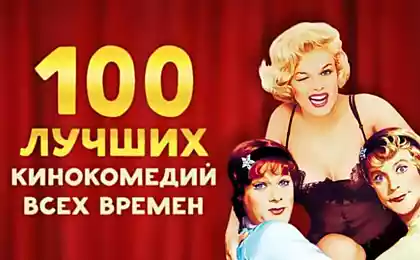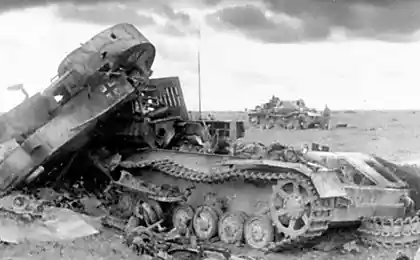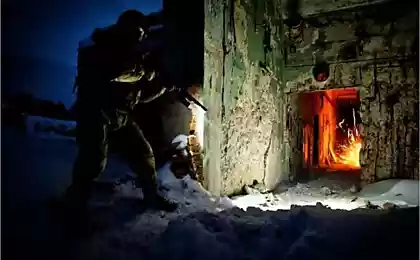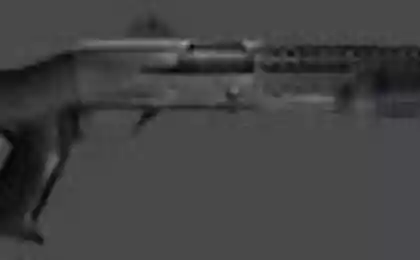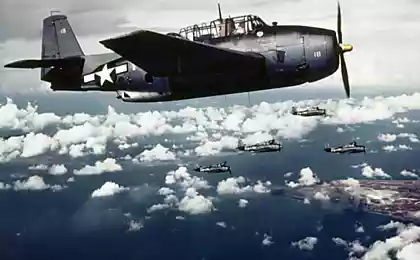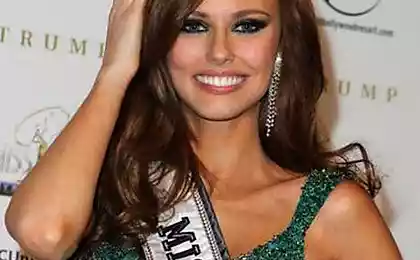2455
Hand grenade shrapnel US
In the US, invented many different kinds and types of hand grenades. In the relatively short history of independence of public education first explosions "pocket artillery" said the weighty "Boom!" In the era of the Civil War of Independence. In those days there was some Granatny agency or bureau, therefore, often initiated the production of a particular model were private individuals. Invented, patented, well, the best examples awarded serial production.
14 photos.
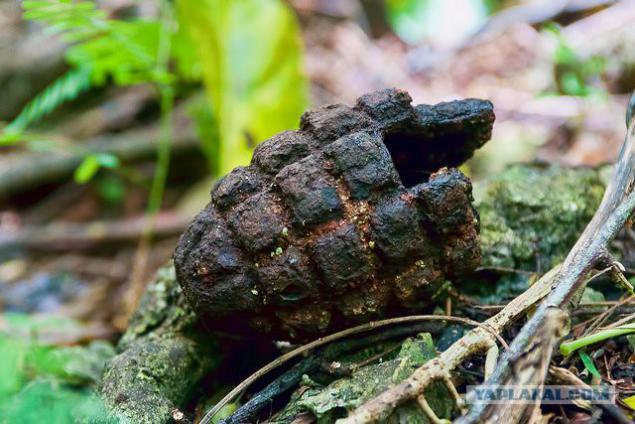
For example, one of the most popular models became pomegranate Ketchum, patented August 20, 1861 a certain William F. Ketchum. She was a cast-iron ellipsoid, with one side of which was a flat platter fuse push action, and on the other - shank stabilizer needed to grenade landed plate of down. Large-scale use of these weapons has not produced the desired effect. Stabilizer worked poorly, and in some cases, played into the hands of the enemy. At the siege of Port Hudson Confederates abandoned iron pots just caught and sent back the sheets on the walls. And those falling from the top down, still explode. At Confederation troops even had my own copy of the product Ketchum - pomegranate Reines, who had upgraded stabilizer and fuse.
Ketchum grenade ...
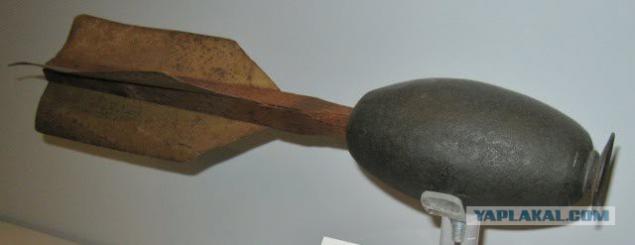
... And Reines

Pomegranate capsule Hans Excelsior development beginning in 1862 is similar to mine, and anchor the principle of operation is similar to it. Was an iron ball with spikes sticking out of it push fuses. In order to advance the device does not work, was provided with an extra outer housing consisting of two shells. Before using one half had to be removed, screwed into the open part of the grenade fuses and then use the second half of the body as the handle, throw it into the goal. Ammunition was very dangerous in the first place to apply. Moreover, the known cases of the use of this model in action no. Nevertheless, pomegranate, though rarely, but comes in museums and private collections. Here it is impossible not to focus on the fact that it was the first (or one of the first) attempt to create a hand grenade Americans with percussion fuze. Despite the outward simplicity, this problem has not found the solution yet. Even the Soviet RGO RGN and have backup detonator with a slowdown. So the question is 100% safe and secure percussion grenade fuzes remains open even after a half century.
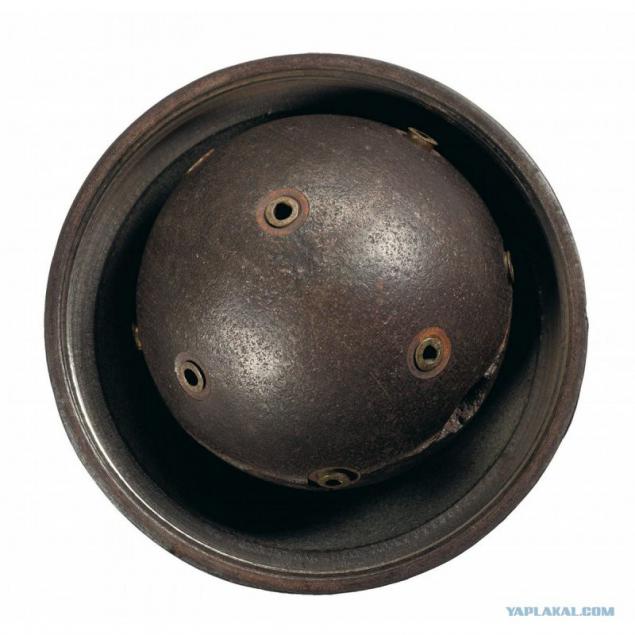
Excelsior grenade in a case and screwed fuses
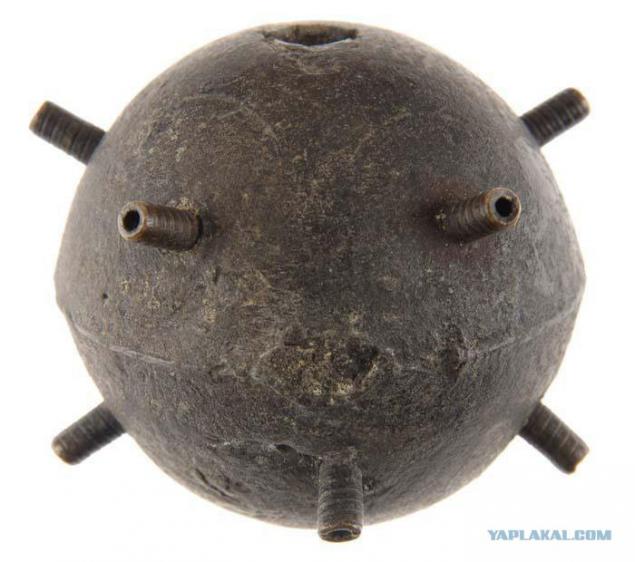
Pomegranate Adams. Precise description of the ammunition did not help, but to save the drawing can be seen that it was developed in 1865, and the principle of operation is based on the use of grating fuse with the slowdown. Very progressive at the time contraption, and use a grater detonators perfectly manifested itself in German grenades during the First and Second World Wars, many airsoft still happy to use.
Adams grenade with fuse grating

In addition to the above, in the vastness of fighting the US Civil War in full use as ersatz grenades made of artillery ammunition and factory iron castings with good old wick fuses. Wick can not accurately calculate the burning time and had a tendency to "lumbago" when firing a beam slipped some distance that short fuse could lead to a premature explosion. Also found some use grenades and foreign models.
Truly the era of hand fragmentation grenades as standard equipment a soldier, not the sort of "vundervaffe" requires a separate kind of troops, came with the outbreak of World War II. It was then that all self-respecting state began to actively implement this type of ammunition to the troops. Since the United States also took part in the crucible of European hostilities, it is quite natural, and got his model. The first American defensive grenade was designated Mk I, was developed and put into service in 1917, the curtain of war. Did not last long, as was a five-speed system start-up and was too complex to use. Often in the heat of battle the soldiers did not announce the initiation of the procedure to the end, to no avail threw grenades into the enemy, only to get her own back, only to have cocked. And all this despite the fact that it was developed and training - Mk IA1. It is reasonable that in 2 years on arms received a new, easier to handle, Mk II, and his firstborn tried safely forget.
Mk I
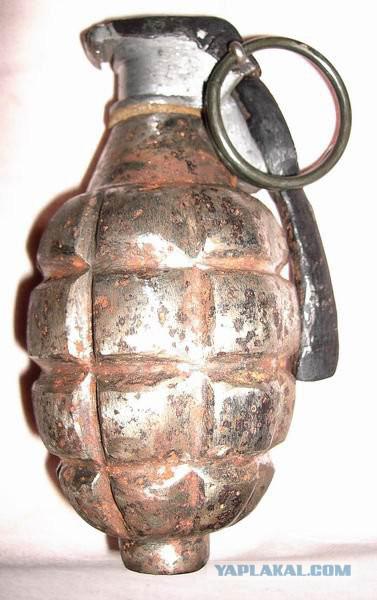
Mk II - Hand grenade developed in 1918 and was in service since 1920. We used up to the Vietnam War. Basically has a cast iron body with notches filled with high explosive (HE). The use of explosive filler - smokeless powder did not require the presence of a detonator, so as to make a simple fuse igniter powder with a reliable moderator. Notches on the body were originally intended to facilitate the division into submunitions, but later found out that iron breaks in the abstract, but a grenade scored just comfortable to hold and throw.
There were several modifications Mk II. For example, in the case originally had two openings for the fuse top and bottom backfill BB eventually rejected from the bottom of the hole. Garnet in informal circles called Mk IIA1, but the military because it was never called. Was the model instead of gunpowder filled with TNT, which had a striking feature - too small fragmented body of TNT charge. Submunitions receive very small and easily lost stopping power. These grenades were painted in bright yellow color (then simply applied to the yellow stripe) and were designated Mk II HE (high explosive).
Mk II HE
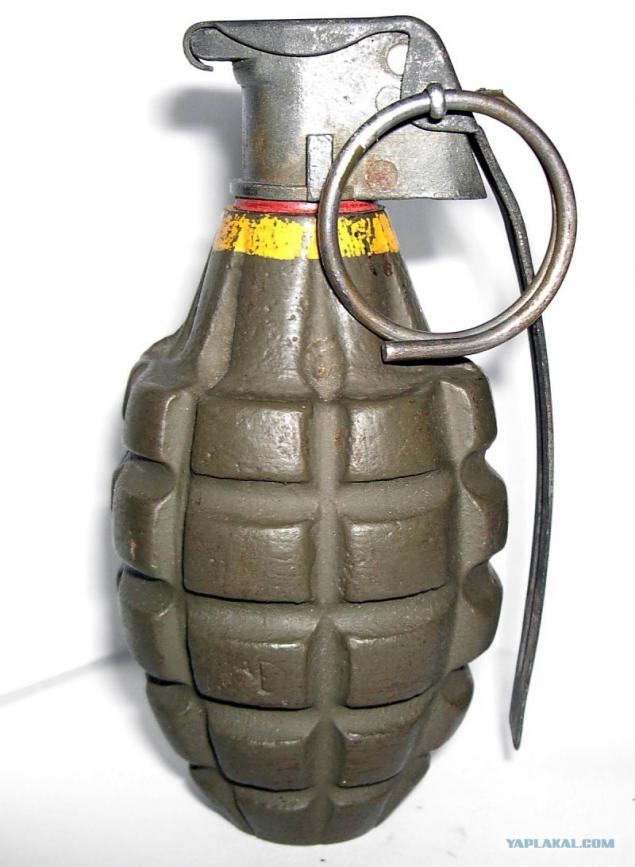
Also for military history of the grenades used different fuses - M5, M6, M10 and M11. M5 and M6 when the ignition is noticeably sparks and loud hissing M10. When using TNT filler documented cases of primer-igniter tripped the main charge. By the end of the service all the grenades equip safe and noiseless fuses M204.
Were in service and training "ananaski." This is a slang term for a grenade was characteristic body shape, so that we "pineapples", and they have - "ananaski».
Transportation TNT versions performed with removed fuses and gunpowder were delivered fully assembled to the powder does not spill. Information on the use of caps on Soviet F-1 no. In April 1945, as part of the overall reorganization of the army identifiers from Roman numerals refused, and pomegranate was given a new designation Mk 2
M21 training
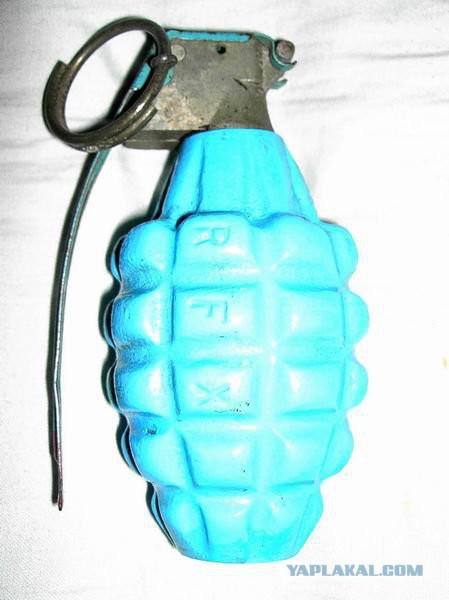
And so it was. Special nozzle for firing a rifle grenade

Mk III (Mk 3) - Hand grenade Blast, designed specifically for operations in confined spaces. Is an interesting notion. The body is made of thick cardboard, and metal parts from only the top and bottom of the cover and fuse. Casts not so much debris as the shock wave from the explosion of a large amount of explosives (227 gr). Waves generated indoors, magnified by the effect of reflection. This model appeared in March 1918 as protivobunkernaya, but the use of found mainly for operations inside buildings. According to the memoirs user: "Explosion Mk 3 indoors able to quickly finish the fight and there is no fear that the shrapnel will pass through the thin walls and amaze us". Also taken up by the Navy as protivovodolaznaya. At the moment, slowly disappear from "counter" as the last remaining customer - Navy developed a new grenade (depth charge), it is dedicated to the fight against divers - Mk40.
There were three different modifications of different body material used and fuses. There is anecdotal evidence that replaced in infantry units come (or are about to come) thermobaric grenades, but the specifics have been found. At least, if the Russian WP-60TB developed, why not exist US counterpart.
Mk III
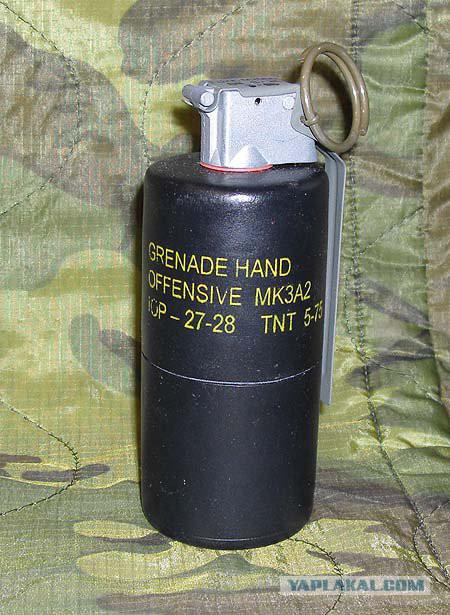
M26 - designed to replace the Mk 2 grenade fragmentation. Designers tried to rob a new product deficiencies of the previous model - namely, the fragmentation of unstable housing. Powder charge tore predecessor too large pieces with a reliable Slaughter, but a small number, and TNT gave a cloud of small fragments, while reducing the damage radius. New grenade was made from two stamped halves into which circumferentially placed knurled steel wire. This combination allowed the use of cast BB - "composition B" (a mixture of TNT and RDX) and had better killing power. For an elongated body shape quickly gained the nickname "pineapple", which, however, a phenomenon almost international. She was taken into service in 1952 and the first baptism of fire grenade was held in Korea, where good account of itself, but the Vietnamese theater of operations has led to a variation of "jungle" - M61. The fact that soldiers often wore "grenades" over the unloading, the phenomenon was all the rage, and in the jungle a lot of different branches, that and strive to cling to the ring. Installation of additional safety lever has solved the problem. And there were even training grenades with the lever. So designers to note - in the military, too, need to adapt to the consumer.
Primers used M204, M217 and then, on the basis that his actions were similar to the same M5 / M6, their main difference from its predecessors was the absence of sparks and noise during combustion.
M61 with an additional fuse
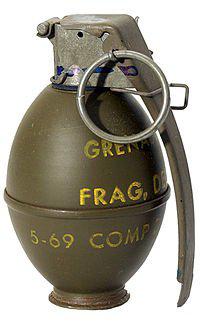
It is clearly seen the wire with notches
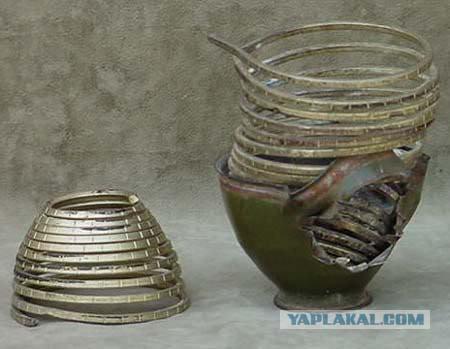
M33 / M67 - M26 has replaced in 1968 and was in service until now grenade. The wire was removed, making an incision on the inside of the package. It's a bit reduced radius of solid lesions (up to 5 meters), which allowed us to use it as offensive and cheaper to manufacture. In addition, the pomegranate was a round to shoot comfortably and accurately. Special attention is given modification of M59. Interestingly munition in that it uses an electromechanical percussion primer M217 (but with duplicate retarder). Impact detonator does not work reliably, and increased up to 7 seconds burning time moderator gives too many chances enemy. Although the attempt and counted, but UDZS used to RGN / RGO comparison does not hold.
History of fragmentation grenades in the United States largely repeats the way of other countries. And you can not say that there have come up with something special or too unfortunate. Overall - quite a good product that performs its tasks. Is that not enough diversity, in contrast to the same range of Soviet, but, you see, and did not need to.
topwar.ru/52780-ruchnye-oskolochnye-granaty-ssha.html
M33 / 67

14 photos.

For example, one of the most popular models became pomegranate Ketchum, patented August 20, 1861 a certain William F. Ketchum. She was a cast-iron ellipsoid, with one side of which was a flat platter fuse push action, and on the other - shank stabilizer needed to grenade landed plate of down. Large-scale use of these weapons has not produced the desired effect. Stabilizer worked poorly, and in some cases, played into the hands of the enemy. At the siege of Port Hudson Confederates abandoned iron pots just caught and sent back the sheets on the walls. And those falling from the top down, still explode. At Confederation troops even had my own copy of the product Ketchum - pomegranate Reines, who had upgraded stabilizer and fuse.
Ketchum grenade ...

... And Reines

Pomegranate capsule Hans Excelsior development beginning in 1862 is similar to mine, and anchor the principle of operation is similar to it. Was an iron ball with spikes sticking out of it push fuses. In order to advance the device does not work, was provided with an extra outer housing consisting of two shells. Before using one half had to be removed, screwed into the open part of the grenade fuses and then use the second half of the body as the handle, throw it into the goal. Ammunition was very dangerous in the first place to apply. Moreover, the known cases of the use of this model in action no. Nevertheless, pomegranate, though rarely, but comes in museums and private collections. Here it is impossible not to focus on the fact that it was the first (or one of the first) attempt to create a hand grenade Americans with percussion fuze. Despite the outward simplicity, this problem has not found the solution yet. Even the Soviet RGO RGN and have backup detonator with a slowdown. So the question is 100% safe and secure percussion grenade fuzes remains open even after a half century.

Excelsior grenade in a case and screwed fuses

Pomegranate Adams. Precise description of the ammunition did not help, but to save the drawing can be seen that it was developed in 1865, and the principle of operation is based on the use of grating fuse with the slowdown. Very progressive at the time contraption, and use a grater detonators perfectly manifested itself in German grenades during the First and Second World Wars, many airsoft still happy to use.
Adams grenade with fuse grating

In addition to the above, in the vastness of fighting the US Civil War in full use as ersatz grenades made of artillery ammunition and factory iron castings with good old wick fuses. Wick can not accurately calculate the burning time and had a tendency to "lumbago" when firing a beam slipped some distance that short fuse could lead to a premature explosion. Also found some use grenades and foreign models.
Truly the era of hand fragmentation grenades as standard equipment a soldier, not the sort of "vundervaffe" requires a separate kind of troops, came with the outbreak of World War II. It was then that all self-respecting state began to actively implement this type of ammunition to the troops. Since the United States also took part in the crucible of European hostilities, it is quite natural, and got his model. The first American defensive grenade was designated Mk I, was developed and put into service in 1917, the curtain of war. Did not last long, as was a five-speed system start-up and was too complex to use. Often in the heat of battle the soldiers did not announce the initiation of the procedure to the end, to no avail threw grenades into the enemy, only to get her own back, only to have cocked. And all this despite the fact that it was developed and training - Mk IA1. It is reasonable that in 2 years on arms received a new, easier to handle, Mk II, and his firstborn tried safely forget.
Mk I

Mk II - Hand grenade developed in 1918 and was in service since 1920. We used up to the Vietnam War. Basically has a cast iron body with notches filled with high explosive (HE). The use of explosive filler - smokeless powder did not require the presence of a detonator, so as to make a simple fuse igniter powder with a reliable moderator. Notches on the body were originally intended to facilitate the division into submunitions, but later found out that iron breaks in the abstract, but a grenade scored just comfortable to hold and throw.
There were several modifications Mk II. For example, in the case originally had two openings for the fuse top and bottom backfill BB eventually rejected from the bottom of the hole. Garnet in informal circles called Mk IIA1, but the military because it was never called. Was the model instead of gunpowder filled with TNT, which had a striking feature - too small fragmented body of TNT charge. Submunitions receive very small and easily lost stopping power. These grenades were painted in bright yellow color (then simply applied to the yellow stripe) and were designated Mk II HE (high explosive).
Mk II HE

Also for military history of the grenades used different fuses - M5, M6, M10 and M11. M5 and M6 when the ignition is noticeably sparks and loud hissing M10. When using TNT filler documented cases of primer-igniter tripped the main charge. By the end of the service all the grenades equip safe and noiseless fuses M204.
Were in service and training "ananaski." This is a slang term for a grenade was characteristic body shape, so that we "pineapples", and they have - "ananaski».
Transportation TNT versions performed with removed fuses and gunpowder were delivered fully assembled to the powder does not spill. Information on the use of caps on Soviet F-1 no. In April 1945, as part of the overall reorganization of the army identifiers from Roman numerals refused, and pomegranate was given a new designation Mk 2
M21 training

And so it was. Special nozzle for firing a rifle grenade

Mk III (Mk 3) - Hand grenade Blast, designed specifically for operations in confined spaces. Is an interesting notion. The body is made of thick cardboard, and metal parts from only the top and bottom of the cover and fuse. Casts not so much debris as the shock wave from the explosion of a large amount of explosives (227 gr). Waves generated indoors, magnified by the effect of reflection. This model appeared in March 1918 as protivobunkernaya, but the use of found mainly for operations inside buildings. According to the memoirs user: "Explosion Mk 3 indoors able to quickly finish the fight and there is no fear that the shrapnel will pass through the thin walls and amaze us". Also taken up by the Navy as protivovodolaznaya. At the moment, slowly disappear from "counter" as the last remaining customer - Navy developed a new grenade (depth charge), it is dedicated to the fight against divers - Mk40.
There were three different modifications of different body material used and fuses. There is anecdotal evidence that replaced in infantry units come (or are about to come) thermobaric grenades, but the specifics have been found. At least, if the Russian WP-60TB developed, why not exist US counterpart.
Mk III

M26 - designed to replace the Mk 2 grenade fragmentation. Designers tried to rob a new product deficiencies of the previous model - namely, the fragmentation of unstable housing. Powder charge tore predecessor too large pieces with a reliable Slaughter, but a small number, and TNT gave a cloud of small fragments, while reducing the damage radius. New grenade was made from two stamped halves into which circumferentially placed knurled steel wire. This combination allowed the use of cast BB - "composition B" (a mixture of TNT and RDX) and had better killing power. For an elongated body shape quickly gained the nickname "pineapple", which, however, a phenomenon almost international. She was taken into service in 1952 and the first baptism of fire grenade was held in Korea, where good account of itself, but the Vietnamese theater of operations has led to a variation of "jungle" - M61. The fact that soldiers often wore "grenades" over the unloading, the phenomenon was all the rage, and in the jungle a lot of different branches, that and strive to cling to the ring. Installation of additional safety lever has solved the problem. And there were even training grenades with the lever. So designers to note - in the military, too, need to adapt to the consumer.
Primers used M204, M217 and then, on the basis that his actions were similar to the same M5 / M6, their main difference from its predecessors was the absence of sparks and noise during combustion.
M61 with an additional fuse

It is clearly seen the wire with notches

M33 / M67 - M26 has replaced in 1968 and was in service until now grenade. The wire was removed, making an incision on the inside of the package. It's a bit reduced radius of solid lesions (up to 5 meters), which allowed us to use it as offensive and cheaper to manufacture. In addition, the pomegranate was a round to shoot comfortably and accurately. Special attention is given modification of M59. Interestingly munition in that it uses an electromechanical percussion primer M217 (but with duplicate retarder). Impact detonator does not work reliably, and increased up to 7 seconds burning time moderator gives too many chances enemy. Although the attempt and counted, but UDZS used to RGN / RGO comparison does not hold.
History of fragmentation grenades in the United States largely repeats the way of other countries. And you can not say that there have come up with something special or too unfortunate. Overall - quite a good product that performs its tasks. Is that not enough diversity, in contrast to the same range of Soviet, but, you see, and did not need to.
topwar.ru/52780-ruchnye-oskolochnye-granaty-ssha.html
M33 / 67




